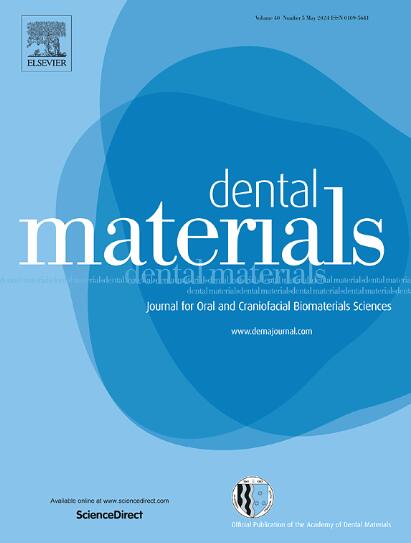添加/替代生物活性玻璃对水工硅酸钙水泥的影响研究。
IF 6.3
1区 医学
Q1 DENTISTRY, ORAL SURGERY & MEDICINE
引用次数: 0
摘要
目的:评价添加或替换生物活性玻璃(BG)对放射性硅酸三钙水泥(TCS)理化、抗菌和生物学性能的影响。方法:对四种材料进行试验:实验水泥中TCS含量为80 %,氧化锆(z基)含量为20 %;两个改进版本的TZ-base包含20% % BG 45S5作为tcs替换(TZ-bg-R)或添加(TZ-bg-A);和Biodentine (septodon)。采用ISO 6876:2012方法评估凝固时间。材料浸泡在含有10 %胎牛血清(DMEM-sup)的水中或Dulbecco's改良eagle培养基中。7天后,使用ISO 4049:2019方法评估吸水性和溶解度;计算吸水率和孔隙率;分别用pH计和电感耦合等离子体测定渗滤液碱度和钙释放量;采用扫描电镜、x射线能谱和x射线衍射分析对样品进行了表征。第一天,检测材料表面和渗滤液对粪肠球菌和表皮葡萄球菌生物膜的抗菌性能;采用3-(4,5二甲基噻唑-2-基)-2,5-二苯基溴化四唑试验和酶联免疫吸附试验评估渗滤液的细胞毒性和细胞因子释放。所有因变量均拟合回归模型。结果:与z碱相比,含bg材料的吸水性、吸水性和孔隙率总体上有所提高;在dmme -sup中的溶解度降低;降低钙释放;pH值、抗菌活性、细胞毒性和细胞因子释放量大致相似。所有实验水泥的细胞毒性均高于生物牙汀,但后者引起更高的细胞因子释放。意义:无论是添加还是替代骨水泥,bg掺入都降低了在临床相关介质中的溶解度,并且没有恶化材料的抗菌和生物学特性。本文章由计算机程序翻译,如有差异,请以英文原文为准。
Investigation of the effect of addition/replacement of bioactive glass to hydraulic calcium silicate cement
Objectives
Assess the effect of addition or replacement of bioactive glass (BG) on the physico-chemical, antibacterial and biological properties of radiopacified tricalcium silicate cement (TCS).
Methods
Four materials were tested: An experimental cement with 80 % TCS, 20 % zirconium oxide (TZ-base); two modified versions of TZ-base incorporating 20 % BG 45S5 either as TCS-replacement (TZ-bg-R) or addition (TZ-bg-A); and Biodentine (Septodont). Setting time was assessed using ISO 6876:2012 method. Materials were immersed in water or Dulbecco's modified eagle medium with 10 % fetal bovine serum (DMEM-sup). After seven days, water sorption and solubility were assessed using ISO 4049:2019 methods; water uptake and porosity were also calculated; leachate alkalinity and calcium release were assessed with a pH meter and inductively coupled plasma respectively; specimens were characterized with scanning electron microscopy, energy dispersive X-ray and X-ray diffraction analysis. At one-day, antibacterial properties of material surfaces and leachates were tested against Enterococcus faecalis and Staphylococcus epidermidis biofilms; leachate cytotoxicity and cytokine release were assessed with the 3-(4,5 dimethylthiazolyl-2-yl)-2,5-diphenyl tetrazolium bromide assay and an enzyme-linked immunosorbent assay. Regression models were fitted for all dependent variables.
Results
Compared to TZ-base, the BG-containing materials had overall increased water sorption, water uptake and porosity; decreased solubility in DMEM-sup; lower calcium release; and generally similar pH, antibacterial activity, cytotoxicity and cytokine release. All experimental cements were more cytotoxic than Biodentine, but the latter caused higher cytokine release.
Significance
The BG-incorporation whether added or replacing the cement decreased the solubility in clinically relevant media and did not deteriorate the antimicrobial and biological properties of the materials.
求助全文
通过发布文献求助,成功后即可免费获取论文全文。
去求助
来源期刊

Dental Materials
工程技术-材料科学:生物材料
CiteScore
9.80
自引率
10.00%
发文量
290
审稿时长
67 days
期刊介绍:
Dental Materials publishes original research, review articles, and short communications.
Academy of Dental Materials members click here to register for free access to Dental Materials online.
The principal aim of Dental Materials is to promote rapid communication of scientific information between academia, industry, and the dental practitioner. Original Manuscripts on clinical and laboratory research of basic and applied character which focus on the properties or performance of dental materials or the reaction of host tissues to materials are given priority publication. Other acceptable topics include application technology in clinical dentistry and dental laboratory technology.
Comprehensive reviews and editorial commentaries on pertinent subjects will be considered.
 求助内容:
求助内容: 应助结果提醒方式:
应助结果提醒方式:


